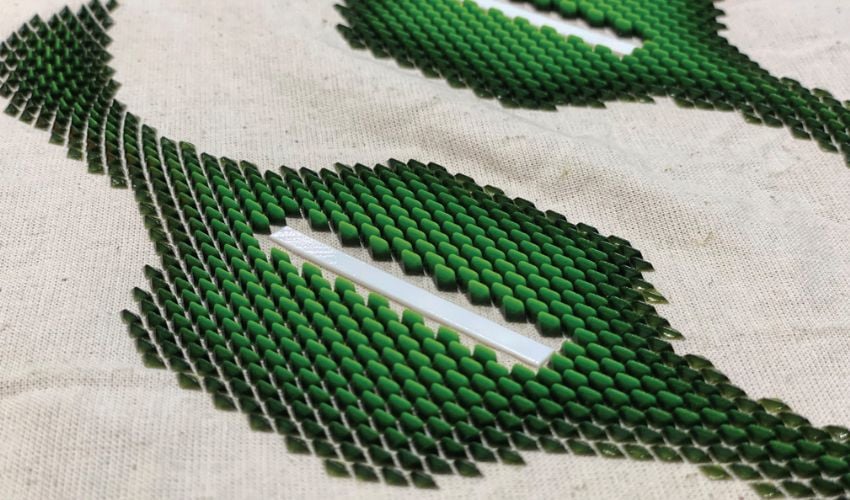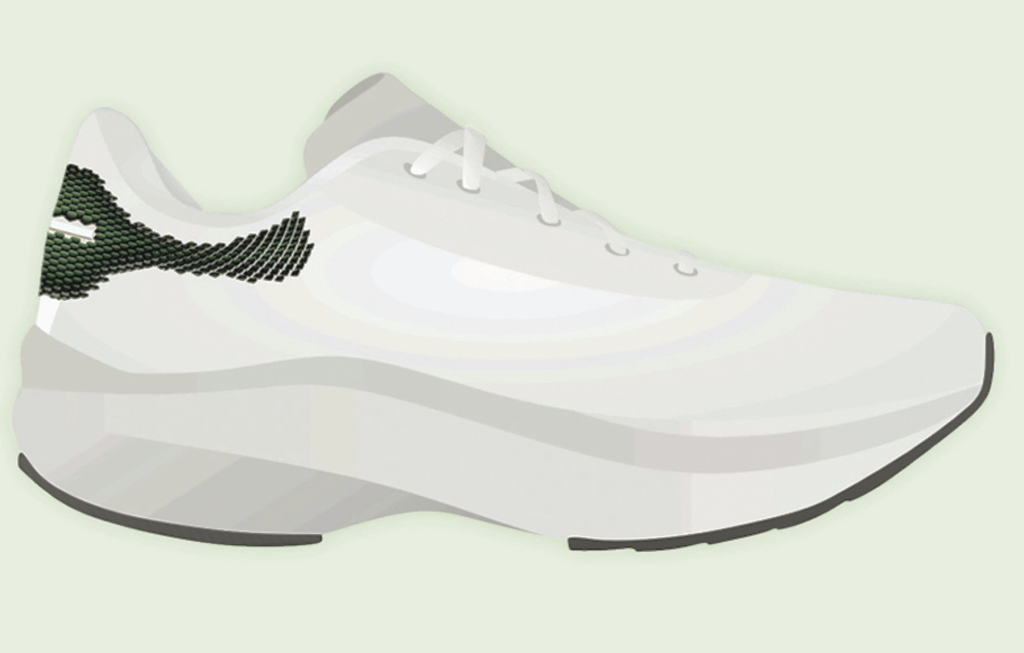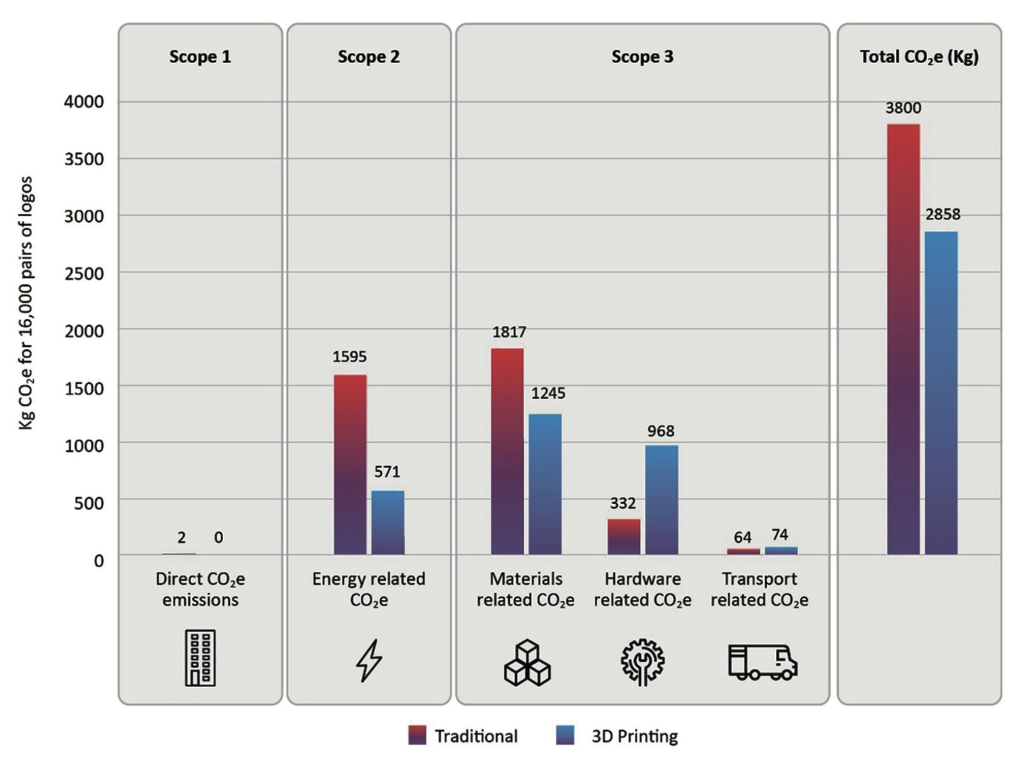Global trade group Additive Manufacturer Green Trade Association (AMGTA) has published a study highlighting the environmental benefits of additive manufacturing within the fashion industry.
Titled ‘Comparative Analysis: 3D Material Jetting vs Traditional Methods for Designer Luxury Goods’, the year-long study analyzed the cradle-to-gate environmental impact of a 3D logo attached to the heel of a luxury athletic shoe.
The report found that the 3D printed component, produced via material jetting, generated a much smaller environmental impact than the part manufactured with traditional processes.
In fact, The 3D printed component enabled a 24.8% reduction in CO2e emissions, and a 48% reduction in stock material when compared to its traditionally manufactured counterpart.
Commissioned by the AMGTA, the study was conducted by UK-based additive manufacturing consultancy Reeves Insight in collaboration with 3D printer manufacturer Stratasys, Italian luxury fashion firm Pattern Group and its subsidiary, Dyloan Bond Factory.
“We are pleased to issue the third body of research in a series of independently commissioned papers designed to reveal the environmental benefits of additive manufacturing adoption. We are committed to advancing the research and publication required to better understand the sustainable value of AM technologies as part of the manufacturing cycle for broad business cases,” commented Sherri Monroe, the AMGTA’s Executive Director.
“This collaborative study with Stratasys and Pattern Group, assessing the impact of a print-to-textile process, is our first research undertaking involving polymer. It delivers important data that supports the value of AM to impact one of the most historically polluting industries in the world.”
Stratasys CEO Dr. Yoav Zeif added, “This study showcases how the adoption of our advanced AM offering empowers customers to deliver manufacturing solutions that improve their impact on the environment and at the same time deliver competitive advantage through innovation in production for design.”

How was the study conducted?
Commissioned in 2022, the study compared the production of a 3D shoe accessory using both traditional and additive manufacturing techniques.
The traditional multiple-step process included 2D inkjet printing and thermal welding of injection molded parts with sheet polyurethane materials. On the other hand, the additive manufacturing process required significantly fewer steps, and included material jetting using photocurable liquid resins.
The study evaluated and compared both processes, with a production run of 16,000 logo components for 8,000 pairs of shoes. The additively manufactured parts were produced using the Stratasys Polyjet J850 TechStyle 3D printer.
The post-manufacturing analysis considered the environmental impact of the manufacturing processes and materials used. The primary analysis metrics were air, water, and land emissions. In the report, air emissions are presented as Global Warming Potential (GWP) measured in carbon dioxide equivalent units (CO2e).
It is worth noting that this study did not provide a full Life-Cycle-Analysis (LCA) of the final footwear. Instead, a detailed Life-Cycle-Inventory (LCI) for the 3D logo component manufacturing stage, leading to eventual footwear production, was provided.
All inputs to and outputs from the manufacturing stage were evaluated in this study. The inputs assessed were energy and raw materials. The outputs include emissions to air, water, and soil; solid waste generation; products; and co-products.

Key findings of the study
Ultimately, 3D printing using material jetting was found to produce 24.8% less CO2e emissions than the traditional manufacturing process.
Across the 16,000 logo components, 3D printing delivered one metric tonne less CO2e into the atmosphere. The report also noted that improving the efficiency and productivity of the 3D printer could reduce these CO2e emissions even further.
3D printing was found to require 49.3% less material by weight than the traditional manufacturing supply chain, representing one-third of a metric ton less of stock material. Overall, the 3D printed accessory features 50.5% less material than its traditional counterpart, resulting in a more light-weight final product.
The study also noted that over 300,000 liters of water was required to traditionally manufacture the 16,000 logo components. This is due to the use of a paper-backed PU sheet as the primary binding agent. 3D printing required no water.
In terms of energy consumption, the traditional injection molding and thermal bonding manufacturing approaches used 7,122 kWh of electrical energy. Alternatively, material jetting 3D printing only required 2,548 kWh, 64% less electricity than conventional manufacturing.
However, the study highlighted that both conventional and additive manufacturing processes generated around 150 kg of non-recyclable waste. The traditional manufacturing also produced 131 kg of recyclable waste, with no recyclable waste streams associated with the 3D printing approach.
Moreover, the traditional manufacturing supply chain was found to have a slightly lower environmental impact than the 3D printing supply chain, with regard to transport-related emissions. This disparity was driven by the longer distances associated with transporting speciality resins, with traditional manufacturing using local supply chain partners.

Calculating the sustainability of additive manufacturing
Additive manufacturing is certainly seeing a growing focus on sustainability. Earlier this year, AMGTA conducted an LCA comparing traditional casting to binder jetting for an industrial part.
This LCA was conducted by the Yale School of the Environment (YSE) in collaboration with industrial 3D printer manufacturer Desktop Metal and US-based “climate innovator” Trane Technologies. Ultimately, binder jet 3D printing showed a 38% reduction in greenhouse gas emissions. This was driven by reduced energy demand during production.
Elsewhere, 3D Printing Industry attended AM Summit 2023, Scandinavia’s largest additive manufacturing conference. Here, there was a significant focus on sustainability and 3D printing.
During the Copenhagen-based conference, During AM Summit 2023, Marie Langer, CEO of 3D printer manufacturer EOS, outlined the benefits of the company’s 3D printing Cost and Carbon Calculator. This online tool provides transparent 3D printing cost and carbon analysis, visual analytics, cost sensitivity analysis, report generation, data-driven design, and customized cases for customer pricing.
According to Langer, the calculator makes it easy “for our customers looking at specific applications to calculate carbon emissions and also share the pricing to really evaluate the green business case.”
Similarly, Danish AM Hub, the organizers of AM Summit, has developed its own CO2e calculator. This tool directly compares the CO2e emissions of 3D printing with conventional manufacturing for a set component. Designed with simplicity in mind, this calculator outputs one number – indicating the amount CO2 saved or gained by using additive manufacturing.
The Danish AM Hub CO2e calculator was leveraged by Danish-based industrial machinery firm Danfoss. Using this tool, the company conducted a CO2e calculation on a metal crossbar component. 3D printing was found to be 30% more sustainable than CNC machining, saving 400 kg of CO2 per variant.
Subscribe to the 3D Printing Industry newsletter to keep up to date with the latest 3D printing news. You can also follow us on Twitter, like our Facebook page, and subscribe to the 3D Printing Industry Youtube channel to access more exclusive content.
Are you interested in working in the additive manufacturing industry? Visit 3D Printing Jobs to view a selection of available roles and kickstart your career.
Featured image shows the heel spur logo component. Image via AMGTA.


